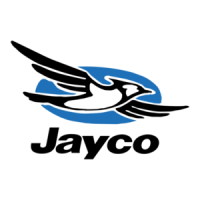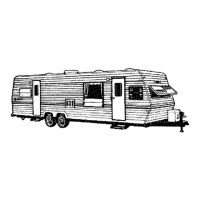Do you have a question about the Jayco Conventional Travel Trailer 2004 and is the answer not in the manual?
General advice on common sense and following procedures for safe trailer operation.
Procedure for reporting vehicle defects that could cause crashes, injury, or death.
Essential information for the safe handling and operation of the LP gas system.
Instructions for testing the LP gas system for leaks using soapy water or detector solution.
Guidelines for safe use of electrical systems, including breakers, fuses, and grounding.
Location, operation, and maintenance of the fire extinguisher for emergency preparedness.
Proper operation and maintenance of the smoke detector for safety warnings.
Actions to take during emergency stops, including using warning flashers and flags.
Important safety checks and procedures before traveling, including tire inflation and brakes.
Considerations for using the trailer in cold weather and extended use, including protection from freezing.
Understanding and controlling condensation to prevent dampness, mildew, and damage.
Importance of obtaining insurance coverage for liability, theft, collision, and property damage.
Understanding trailer weight labels, GVWR, GAWR, and cargo carrying capacity.
Rules for proper cargo loading to ensure safe handling, stability, and weight distribution.
Warning against using the rear bumper for carrying cargo due to potential damage and weight issues.
Warning against traveling with waste in holding tanks due to altered towing characteristics and potential risks.
Process for physically weighing the trailer to verify compliance with weight ratings and ensure proper balance.
Crucial factors for selecting the correct tow vehicle, including tow rating and compatibility.
Information on selecting the correct hitch type and understanding hitch classes and weight ratings.
How a weight distributing hitch system provides a more stable tow vehicle/trailer combination.
Causes of trailer sway and the use of sway control devices for improved stability.
Determining the correct hitch height for level towing and understanding hitch ball size specifications.
Step-by-step guide for properly hitching a conventional travel trailer to a tow vehicle.
Proper attachment and use of safety chains for secure towing, adhering to state laws and SAE standards.
Types of hitches for fifth-wheel trailers and consultation for correct selection.
Considerations for fifth-wheel hitch height to ensure the trailer travels as level as possible.
Step-by-step instructions for hitching a fifth-wheel travel trailer to a pickup truck.
Warning against towing anything behind the RV, as it can cause damage and void the warranty.
Recommendation for using a separator with tire covers to prevent bleeding onto the tire.
Step-by-step procedure for safely changing a trailer tire.
Importance of proper torque for wheel lug nuts to prevent wheel separation and ensure safety.
Factors to consider when choosing a campsite for a comfortable and positive camping experience.
Procedures for un-hitching fifth-wheel and conventional travel trailers at the campsite.
Importance and methods of leveling the RV for proper operation of appliances and comfort.
Procedures for stabilizer jacks, awning setup, and television antenna and cable connections.
Operation and safety precautions for using the slideout room feature.
Connecting to campground utilities like electricity, water, and LP gas systems.
Utilizing the fresh water system, including city water connection and gravity fill tank.
Importance of using a water pressure regulator to protect the plumbing system from high pressure.
Safe procedures for connecting and starting up the LP gas system for appliances.
Proper procedures for connecting the trailer to a sewer system and emptying holding tanks.
Information on operating and maintaining various appliances like the range, microwave, refrigerator, and furnace.
Operating and maintenance instructions for the Atwood water heater.
Using bathroom facilities, including toilet, faucets, and shower.
Care and maintenance instructions for the trailer's toilet.
Operation guidelines for trailer faucets.
Operation and care of the optional exterior shower assembly.
Information on the optional water purification system and filter replacement.
Maintenance information for the air conditioner unit and considerations for low amp service.
Information on the optional two-way family radio system.
Understanding the monitor panel for water tank levels and battery condition.
Overview of entertainment component parts and their operation.
Installation and operation of the optional BBQ grill, including safety warnings.
Instructions for setting up and sanitizing the potable water system.
How to drain the fresh water tanks and supply lines.
Operation of the sanitation system, including toilet, vents, and holding tanks.
Safe handling and operation of the LP gas system, including connections and appliance use.
Attaching the main supply hose from the regulator to the trailer frame manifold.
Proper installation and function of the LP gas regulator for pressure reduction.
Typical LP gas consumption rates for various RV appliances.
Importance and maintenance of the LP gas leak detection device for safety.
A checklist of tasks to complete before leaving a campsite for a safe trip.
Overview of the trailer's electrical system, including 120-volt AC and 12-volt DC circuits.
Information on the 30-amp power cord, hookup, and safe electrical practices.
Function, testing, and safety of GFCI receptacles to prevent electrical shock.
Understanding the 30-amp service, circuit breakers, and power consumption management.
Components of the 12-volt DC system, including power converter, batteries, and lights.
Purpose and installation of a battery isolator for preserving the tow vehicle battery.
Information on exterior and interior lights, including bulb types and wiring connectors.
Cleaning and polishing the exterior metal surface of the trailer.
Routine maintenance for the rubber roof, including inspection and resealing of seams.
Routine maintenance for the fifth-wheel hitch system according to manufacturer recommendations.
Maintenance information for the fifth-wheel trailer landing gear.
Lubrication for the conventional travel trailer hitch actuator and ball.
Lubrication for the coupler's moving mechanisms and actuator.
Lubrication procedure for the trailer's tongue jack.
Inspecting and repainting the trailer frame to prevent rust and deterioration.
Information on lubricating the axle bearings without removing the hubs.
Maintenance requirements for trailer wheel bearings.
Instructions for checking and maintaining wheel lug nuts to ensure safe operation.
Maintenance schedule and proper working condition checks for trailer brakes.
Understanding specific needs of RV tires and following maintenance instructions.
Recommendation for using a separator with tire covers to prevent bleeding onto the tire.
Step-by-step procedure for safely changing a trailer tire.
Procedures for securing the spare tire in the travel position.
Inspecting and resealing seams on the trailer to prevent water damage.
Cleaning instructions for the stone guard.
Inspecting exterior lights for moisture and keeping weep holes clear.
Routine maintenance for the entrance door, including strike plate adjustment and lock lubrication.
Cleaning and care instructions for ABS plastic components.
Cleaning instructions for bathroom tubs, sinks, and fixtures.
Cleaning the shower curtain liner.
Care and maintenance instructions for the trailer's toilet.
Vacuuming and cleaning furniture for maintenance.
Care instructions for cushions, including vacuuming and cleaning.
Guidelines for cleaning window treatments like blinds, shades, and drapes.
Cleaning and repair instructions for vinyl-covered wall paneling.
Care instructions for the vinyl floor covering.
Vacuuming and cleaning recommendations for the trailer's carpeting.
Cleaning instructions for countertops.
Steps to manually move the slideout if the electric system fails.
Maintenance information for the TV antenna.
Preventive maintenance and safety checks for the furnace.
Steps to follow for obtaining service and maintenance for your RV.
Steps to follow for obtaining service and maintenance for your RV.
Role and importance of authorized dealers for service, maintenance, and parts.
Information on how to obtain replacement parts through authorized dealers.
Owner's responsibility for understanding and performing regular maintenance to avoid warranty issues.
Contact information for manufacturers of various RV components and appliances.
| Brand | Jayco |
|---|---|
| Model | Conventional Travel Trailer 2004 |
| Category | Motorhomes |
| Language | English |











